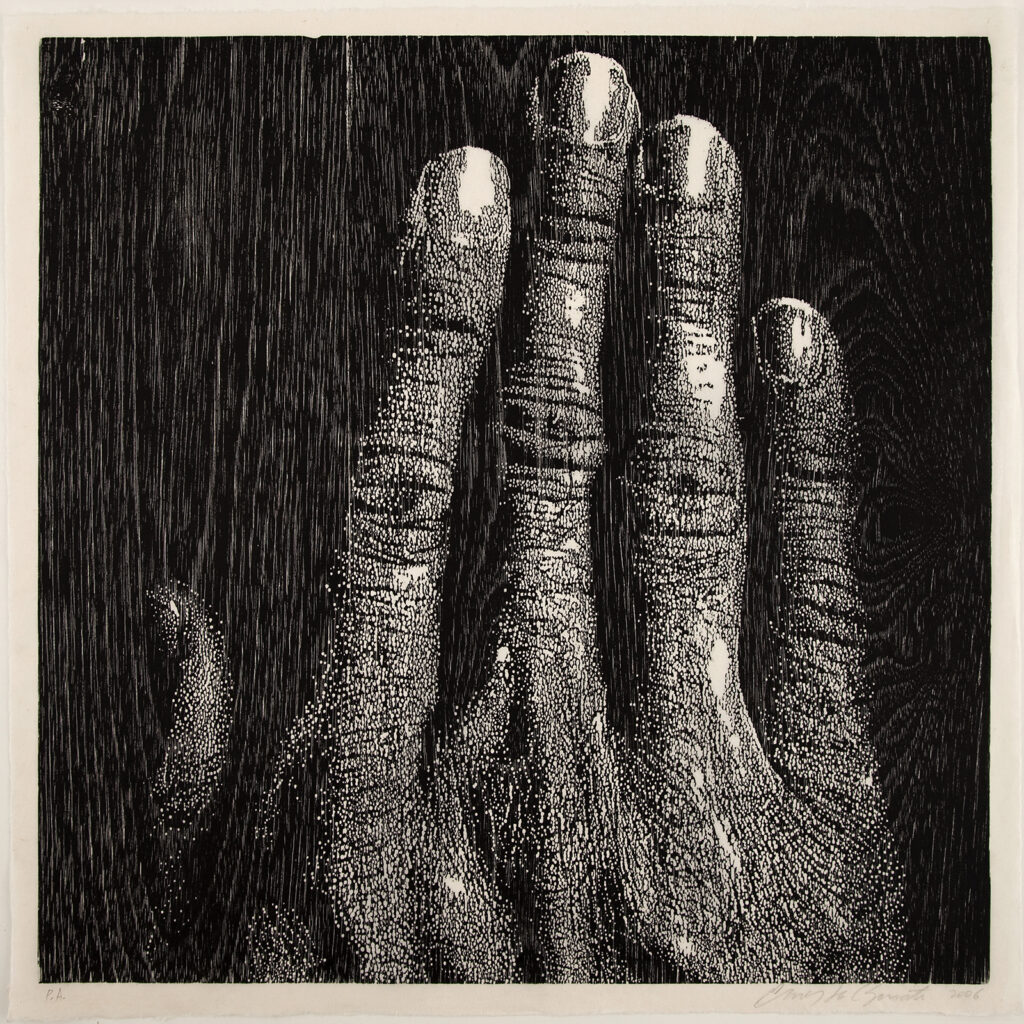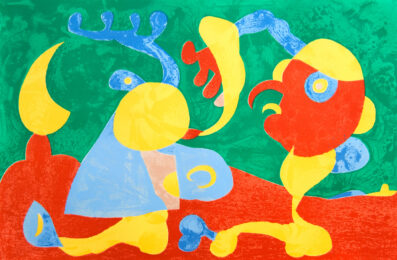Behind The Print | Deambulatory Series – Hand by Ernesto Bonato
About the ‘Ambulatory’ series text by the artist Ernesto Bonato.
I started these images in 2006 with the desire to attribute to some photographs that I had taken since the previous year a mysteriously natural quality, as if they sprouted from a rough surface – a piece of wood – and floated on its surface like a foam that is born from the movements deep sea. I wanted these images to keep something of their photographic nature, but to distance themselves from the material quality of a common photographic enlargement, always colder than a print, in my opinion. The first movement, perhaps more obvious, but no less valid for that reason, was wanting to make them using photogravure resources that I already mastered relatively well at the time, but the truth is that I saw these images sprouting from wood and not from a sheet of paper. These images needed to be dissolved, softened, modeled by hand in order to lose the mimetic rigidity of the photographic record and become “warmer”, more alive, something I always associate with drawing. That’s why I decided to engrave them manually on wood, even if starting from a photographic print, so that it would be possible to lead the image to an undefined field between drawing, printmaking and photography, where it would not be easy to specify its nature. At the same time, I needed this engraving to be as “natural” and subtle as possible, because, as I said, I wanted the image to have the appearance of something that sprouted from the wood almost spontaneously, as if it were the fruit of the wood itself or of an animal. who lives in it. Intuition led me to make a first experiment on a small scale using punches of different diameters instead of the cutting tools usually used in woodcuts. The result was a somewhat ghostly image, without the bodily weight that the cut and the line give the shape and without the obvious mark of the cultivated hand, which betrays the polite human gesture, perhaps impossible to eliminate from the line. Even so, the image preserved a non-mechanical, human quality, a warmth and intelligence that are characteristic of drawing.
It was a delicate move to place myself among so many things that speak so loudly and for themselves and find a middle ground that was smooth and powerful at the same time. I opted for this minimal action of pushing the wood fibers down with larger diameter tips or simply opening space between them, with finer tips, never removing material.
The translation of the continuous tones present in the original photograph was achieved by the construction of an organic grid that, in addition to having the variation of the diameters of the points and their spacing (variables present in most of the grids obtained mechanically), incorporated the interpretation of the structures, of the lines of force, volumes, etc., visible in the gesture of the person who draws. In this way, the reticle accompanied the movement of the represented object, interpreting its structure with understanding and malleability, even proposing variations in the contrast and limits of the original photographic image, something impossible to obtain with a mechanically generated reticle. Here, too, intuition made me choose cedar, which I later found, when I tried many others, to be the best wood for this type of engraving, in addition to providing the image with its veins, intensifying the sensation that the figure was sprouting from the wood as they merged up with its own engraved reticle.
The chosen figures relate to Sacred iconography, although they are neither commentary nor intended to be sacred in the traditional sense, although they are not (I hope) devoid of a sense of religiosity either. From the beginning, I intended to make a set of 12 different images, but I didn’t define beforehand which ones they would be. A condition that I imposed on myself and that I maintain is to use only photographs taken by me, as I continue to consider this a photographic work as much as an engraving. Until now I recorded six of these images. As you can see, it’s a very slow job. Images have to come with truth, so I wait for them, I don’t look for them. Engraving work also extends over many months, as any mistake in drilling the matrix puts all the work to waste. Recording slowly drags on, a little bit a day, during which time attention remains sharpest. The first time I exhibited the first images was in a Romanesque church from the 11th century, in French Burgundy.
I called this series “Ambulatory”, which corresponds to the part that surrounds the choir and is placed between it and the radiating chapels in large Romanesque or Gothic churches. Studying the symbolic relationships between the human body (and more precisely the body of Christ) and the plans of the main churches of that period can help in understanding the title. There is also a smaller series, in which I use the same technique and which is called “Loose pages of a silent book”, a title that refers to the same universe of medieval cathedrals and, of course, to alchemy books, but the important thing is to understand the original meaning that the title evokes.
The woodcut ‘Hand’ is part of the ‘Ambulatory’ series, started in 2006 and still in development. The series or part of it has already been exhibited in different places such as the church of Anzy Le Duc, Brionnais, France; Galerie d’Engramme, Quebec, Canada; Pratt Institute, New York, USA; Hyllyer Art Space, Washington, USA; IV Engraving Biennial of Santo André (Prize); Museo de Arte de Ciudad Juárez, Chihuahua, Mexico; Mominoki Gallery, Tokyo, Japan; Galeria Gravura Brasileira, São Paulo; Brazil Venezuela Cultural Institute, Caracas; 6th Biennale Internationale D’Estampe Contemporaine de Trois-Rivières, Canada; International Print Center New York, USA; Center de la Gravure et de l’Image Imprimée, Brussels, Belgium; Unicamp Art Gallery, Campinas; Pinacoteca Station, Pinacoteca of the State of São Paulo; Exposición del Encuentro Internacional de Grabado No Tóxico 09. Monterrey, Mexico; Mezzanine Gallery, São Paulo; Guanlan Printmaking Base, Guanlan, Senzhen, China; From Punt. Amsterdam, Netherlands; IPCNY, New York, USA; Sesc Guarulhos, SP; Sesc Pinheiros, SP; Morro da Vargem Zen Monastery, Ibiraçu, ES; Virgílio Gallery, SP; AT/AL/609, Campinas; Gallery Via Thorey, Vitória, ES, among others. The work is reproduced in the book ‘Lugar, Tempo, Olhar’, by Anne Louyot, published by Atelier Editorial in 2009; in the catalog of the exhibition ‘Four Graphic Essays’, organized by Claudio Mubarac and edited by Pinacoteca do Estado de São Paulo in 2012 (sold out) and in the catalog of the VI Biennale Internationale D’Estampe Contemporaine de Trois-Rivières, Canada, 2009. The artwork ‘Hand’, an edition of 12 copies was made on Sekishu paper with a slightly yellowish tone and another, a few years later, of 10 copies on white Sekishu paper, in addition to the corresponding Artist’s Proofs (P.A.). As of 2020, the artist will print this print on demand, on washi paper, without opening a new edition, numbering the prints with Roman numerals.
Courtesy of Galeria Gravura Brasileira.



